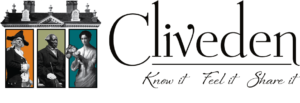About Cliveden
Cliveden is a historic site that preserves and interprets over 200 years of American history through the lives of the Chew Family and their staff, both enslaved and in service. Cliveden produces engaging programming for children and adults to connect the past and the present.
OUR MISSION
Know It. Feel It. Share It.
Cliveden’s mission is to help people understand our shared history and motivate them to preserve it. We achieve this by:
Preserving our buildings, grounds, and collections;
Researching and interpreting Cliveden meaningfully to the public;
Working with our local community to promote preserving and reusing historic buildings;
Promoting our community’s cultural life and preservation efforts; and being a model of historic site management, preservation and interpretation.

Our Team
The Cliveden Staff and Board Members are always interested in your feedback. Contact us if you need any information or have any questions.
Cliveden Staff
Nancy VanDolsen: Chief Executive Officer
Libbie Hawes: Preservation Director
Carolyn Wallace: Education Director
Jocelyn Rouse: Marketing & Development Coordinator
Piper Burnett: Curatorial Housekeeper & Facilities Custodian
Jamie Davenport: Gardener
Michelle Carter-Bailey: Interpreter
Nick Bailey: Interpreter
Felix Haase: Interpreter
Gigi McGraw: Interpreter
Shiloh Mugar: Interpreter
Board of Directors
Conrad Person: Board Chair
Ahsan Nasratullah: Treasurer
Darryl J. Ford: Secretary
Brian Ames
Glenn Bergman
Joan Countryman
Garth Herrick
Alan Keiser
Susan Leidy
Violette Levy
Randall Miller
Theodore Reed
Brad Roeder
Seri Worden
Discover Germantown
At various times a countryside village of German and Dutch yeomen, a retreat for Philadelphia’s well-to-do, a stop on the Underground Railroad, and a haven for African Americans looking for the American Dream, Germantown has been there for all of America’s social, political and economic revolutions and evolutions. Cumulatively, Historic Germantown is one of the richest geographic concentrations of historic resources in the United States, a place where history, memory and everyday life exist side by side.
Historic Germantown Preserved is a consortium of eighteen historic sites, museums, historical organizations and an arboretum located in the Germantown section of Philadelphia. These organizations are joined by a common mission to foster an appreciation of the diverse character and meaning of their cultural heritage in order to preserve and revitalize their community.
Together, they provide knowledge and resources to help preserve Germantown’s historic sites, interpret them to the public, and incorporate them into the life of the local community.
Aces Museum
5801 Germantown Avenue
Philadelphia, PA 19144
215-842-3742Awbury Arboretum
One Awbury Road
Philadelphia, PA 19138
215-849-2855Black Writers Museum
Historic Vernon House
5800 Germantown Avenue
Philadelphia, PA 19144
267-297-3078Cliveden of the National Trust
6401 Germantown Avenue
Philadelphia, PA 19144
215-848-1777Concord School House & Upper Burial Ground
6309 Germantown Avenue
Philadelphia, PA 19144
215-844-1638Ebenezer Maxwell House
200 W. Tulpehocken Street
Philadelphia, PA 19144
215-848-1861
Germantown White House
Deshler-Morris House
5442 Germantown Avenue
Philadelphia, PA 19144
215-965-2305Germantown Historical Society
5501 Germantown Avenue
Philadelphia, PA 19144
215-844-1683Germantown Mennonite Historical Trust
6133 Germantown Avenue
Philadelphia, PA 19144
215-843-0943Grumblethorpe
5267 Germantown Avenue
Philadelphia, PA 19144
215-843-4820Historic Fair Hill
2901 Germantown Avenue at Cambria Street
Philadelphia, PA 19133
215-870-8348Historic Rittenhouse Town
206 Lincoln Drive
Philadelphia, PA 19144
215-438-5711
Hood Cemetery
4901 Germantown Avenue
Philadelphia, PA 19144
215-844-1683Johnson House
6306 Germantown Avenue
Philadelphia, PA 19119
215-438-1768La Salle University Art Museum
1900 W. Olney Avenue
Philadelphia, PA 19141
215-951-1221Lest We Forget Slavery Museum
5501 Germantown Avenue
Philadelphia, PA 19144
215-205-4324Stenton
4601 N. 18th Street
Philadelphia, PA 19140
215-329-7312Wyck
6026 Germantown Avenue
Philadelphia, PA 19144
215-848-1690

